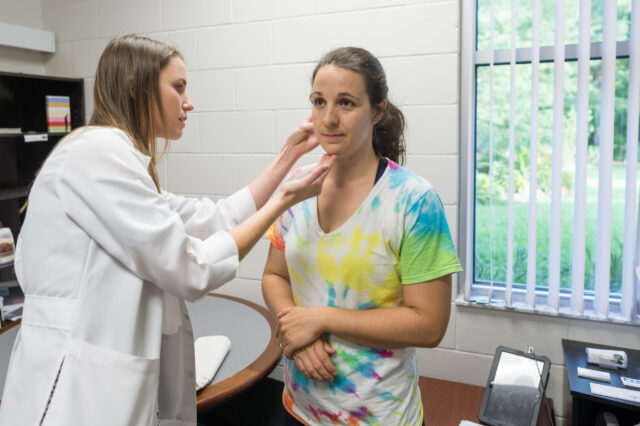Patient education

Definition
Mohs micrographic surgery, also known as Mohs surgery, is a precise surgical technique for removing several types of skin cancers. This technique is most commonly used to treat basal cell carcinomas, squamous cell carcinomas, and other aggressive skin cancers. During Mohs surgery, layers of cancer-containing skin are progressively removed and examined until only normal tissue remains. During this procedure, the area of skin cancer is cleansed, outlined with a pen, and injected with a local anesthetic. A scalpel is utilized to remove the visible portion of the cancer along with a thin, underlying layer of tissue. A temporary bandage is placed over the incision. The tissue is prepared for examination under a microscope – this usually takes about an hour.
The slides are examined microscopically for evidence of additional cancer. If cancer remains, your surgeon notes its location on the Mohs map and uses the map as a guide to remove an additional layer of tissue from your skin, taking care to preserve as much healthy tissue as possible. This process is repeated until a cancer-free tissue sample is obtained.
After all of the cancer has been removed, your dermatologic surgeon will, together with your input, determine the best way to repair the surgical defect. This could include:
- Letting the wound heal on its own
- Closing the wound side-to-side with stiches
- The use a skin graft or flap
- Referral to a plastic surgeon
The dermatologic surgeon typically closes most of the surgical defects. Regular follow-up visits will be scheduled to monitor your wound as it heals and screen for any recurrence of skin cancer.
Make sure your dermatologic surgeon has completed a one-year fellowship endorsed by the American College of Mohs Surgery and the Accreditation Council for Graduate Medical Education.
Alternative names
Mohs surgery
Why the Procedure is Performed
Mohs surgery offers an exceedingly high cure rate for the removal of cancer with minimal damage to surrounding healthy tissue. Mohs surgery is used to remove skin cancers that have a high risk of recurrence, have hard to define borders, or are located in areas where preservation of healthy tissue is critical, such as the head, neck, hands, feet, anterior lower legs, and genitals. Larger and aggressive skin cancers on the trunk and extremities may also be candidates for Mohs surgery.
Risks
As with any surgical procedure, Mohs surgery carries risks, including bleeding, pain, tenderness around the surgical site, infection, and scarring. Other rare complications may include numbness around the surgical area if small nerve endings are cut and weakness of the surgical area if a muscle nerve is cut. Your Mohs surgeon will be vigilant in minimizing any factors that can lead to these potential complications.
Before the Procedure
Mohs surgery is done on an outpatient basis, usually at your dermatologic surgeon's office. If you are anxious, you may be offered oral sedatives. You should set aside the whole day for the procedure. If you take any blood thinners, we recommend that you continue these at the time of the procedure unless you have been instructed otherwise.
After the Procedure
After removal of the skin cancer and repair of the wound, a pressure dressing will be placed on the wound. This will be left on for 48 hours and should be kept clean and dry. After 48 hours, the pressure dressing can be removed and the wound is then covered with petrolatum ointment and a dressing twice daily until your doctor removes the sutures.
Take it easy for a few days! Drink plenty of fluids and eat a soft diet the first 24 hours after surgery. Avoid strenuous exercise, bending, straining, stooping, or lifting heavy objects. Anything that you do that increases your blood pressure can increase your risk of bleeding complications.
If you have any pain, you can take Tylenol (acetaminophen) or the pain medication you were prescribed. Do not take aspirin or ibuprofen or any products containing these unless the doctor approved it or you have a condition for which another doctor prescribed it.
Be alert for any signs of infection, which include:
- Swelling
- Excessive tenderness
- Redness or red streaks
- Heat
- Drainage from the wound (pus)
Avoid drinking alcohol as it can increase your risk of post-operative bleeding and don’t smoke as this can affect surgical repairs and impede wound healing. Even if you can’t quit completely, minimizing smoking while you heal will help.
If you have any problems, call our office at (352) 594-1500.
Outlook (Prognosis)
Mohs surgery is the single most effective technique for treating basal cell carcinomas, squamous cell carcinomas, and other aggressive skin cancers. Cure rates with Mohs surgery for basal cell carcinomas approach 99 percent or better. Similarly, cure rates with Mohs surgery for squamous cell carcinomas range from 94-99 percent. After treatment with Mohs surgery, you will follow-up with your general dermatologist for routine skin cancer surveillance.
Additional Patient Education Resources
To learn more about Mohs surgery, please visit MohsCollege.org.